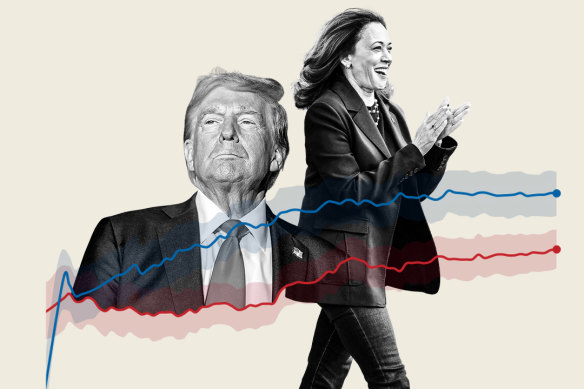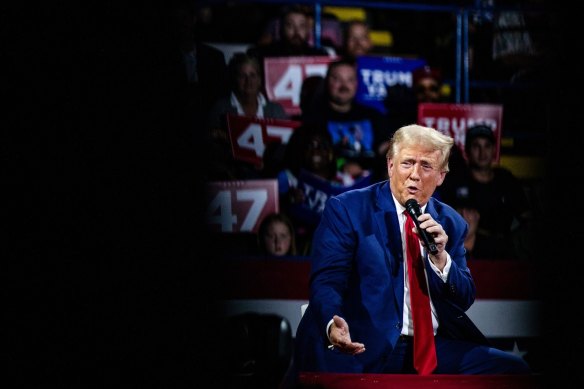This was published 1 year ago
The race may have edged ever so slightly in Donald Trump’s direction
By Nate Cohn
New York: The presidential race just keeps getting tighter.
With three weeks to go, The New York Times’ polling average shows Vice President Kamala Harris and former president Donald Trump essentially tied across the seven key battleground states, with the two separated by less than one percentage point in five of the seven.
It’s hard to think of any election when so many critical states were so close in the polls at this stage.
By our reckoning, 2004 was the last election when the polls showed a candidate leading in the pivotal states by about one point – George W. Bush’s edge in states like Ohio and Wisconsin. But even then, he had a discernible if still narrow edge in the Electoral College. John Kerry needed to sweep most of the close states to prevail. The polling couldn’t really be characterised as a tie, like the polls today.
Before 2004? There’s the 2000 election, of course, but the polls weren’t quite as close as the actual result. Looking even further back, it’s hard to find anything. There has never been an election with so many polls showing such a close race.
Is the race really tightening?
The polling averages are tighter than ever, but that doesn’t necessarily mean there’s been a huge shift – or even any shift – in the race.
The biggest shifts in the average this week were in Michigan and Wisconsin. And in this case, “biggest” does not mean “big”. Trump gained a single point according to our averages – the kind of movement that may feel seismic in such a closely divided and stable election but wouldn’t be worthy of much note in previous cycles. It’s also a shift that’s small enough that one or two high-quality polls for Harris next week could quickly send her numbers back up. Indeed, it was only one or two high-quality polls that brought her numbers down.

Three weeks out, the poll figures have never been closer between Donald Trump and Kamala Harris.Credit: Marija Ercegovac
The pollster that did the most to nudge the average towards Trump was Quinnipiac, which found him ahead by three points in Michigan and two points in Wisconsin. In each case, it was a notable swing from the prior Quinnipiac poll, which traditionally hasn’t been an especially favourable pollster to Republicans.
Two national polls released on Sunday didn’t do as much to swing the average. NBC News found the race tied, down from a five-point lead for Harris a few weeks ago, while she led by two points in the ABC News poll, a drop from six points in its last measure. While these polls did nudge Harris’ lead back under three points nationwide, there were other polls that didn’t support any movement towards Trump – or even showed Harris gaining compared with prior measures — including polls from Pew Research, CBS News/YouGov and our Times/Siena national survey.
On balance, however, this week’s data does suggest that the race may have edged ever so slightly in Trump’s direction. It’s a small enough shift that it could just be statistical noise, but if additional polls showed the same thing, there would be a straightforward explanation: Harris’ modest post-debate bump has worn off with the passage of time and a hectic few weeks of news.
Is this just a red polling wave?
To some, it’s starting to feel as if the polls might err in the same way they did in 2022.
Over the past few weeks, there’s been a deluge of polls from Republican-leaning firms – including firms polling for the Trump campaign. It’s a little reminiscent of what happened before the 2022 midterms when a wave of conservative pollsters flooded the averages over the final stretch and helped cement the impression of a building “red wave”.
But so far, the Republican polling wave isn’t responsible for any major movement in the polling averages. One simple test: what our polling averages would look like if we excluded every poll sponsored by Republicans or conducted by Republican polling firms, along with surveys by any pollsters that I’ve seen being accused of trying to flood the zone for Republicans.

This week’s data suggests that the race may have edged ever so slightly in Donald Trump’s direction.Credit: Bloomberg
How Times polling averages would change without Republican-leaning polls:
- National: Harris +3 (current average) —> Harris +3 (without Republican-leaning polls)
- Arizona: Trump +2 —> Trump +2
- Georgia: Trump <1 —> Trump <1
- Michigan: Harris <1 —> Harris +1
- North Carolina: Trump <1 —> Trump <1
- Pennsylvania: Harris+1 —> Harris +1
- Wisconsin: Harris <1 —> Harris +1
Not very different, are they?
How is that possible?
One factor is that the Republican poll results just aren’t that much different from the non-partisan polls. Back in 2022, the non-partisan polls often showed Democrats well ahead in key Senate races, while the Republican pollsters had a very different story. This time, the Republican pollsters show Trump a tiny bit ahead – say, by a single percentage point in the key states – while the non-partisan pollsters more or less show a tie. It’s just not much of a gap. Those recent Quinnipiac polls, for instance, were arguably better for Trump than the polls by Trump’s own pollsters.
Another factor: our averages don’t usually give much weight to these polls. Historically, polls sponsored by partisans, polls without methodological transparency, and pollsters with a weak track record (three traits that often go hand in hand) tend to produce less accurate and more biased results in the future. They get less weight as a result.
The averages also try to account for whether a poll is sponsored by partisans, which can wind up cancelling out the partisan-lean of any sponsored polls. In fact, there have been cases where it does more than cancel it out. The polls released by the Trump campaign’s pollsters or the Trafalgar Group, for instance, nudged our averages ever so slightly (only by a tenth of a point) towards Harris simply because they weren’t favourable for Trump after considering the lean of a partisan poll.
There’s one final difference: There are more non-partisan polls. In the final week of the 2022 campaign, there were few or, in some cases, no non-partisan polls of the key states.
There aren’t necessarily many non-partisan polls right now, but there are enough to cancel out the limited effect of the polls sponsored by partisans.
This article originally appeared in The New York Times.